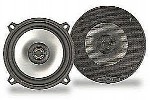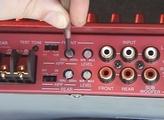Coaxials versus Components Speakers
First, a few definitions. A component (sometimes called separate) speaker system consists of multiple separate speaker components. Typically this will be a 4"-6.5" woofer with a 1" tweeter and a an external passive crossover. A coaxial speaker is a similar woofer with a tweeter either suspended on a bridge above the woofer or on a pole that extends through the middle of the woofer. The crossover is typically only a simple capacitor in-line with the tweeter though higher grade coaxials will have outboard crossovers.
Good example of component speakers:

Good example of coaxial speakers:

Generally component speakers are better than coaxial speakers but that's a manufacturer's decision. It's cheaper to make a coaxial speaker with inferior components than it is to make a cheap component set. Coaxial designs have the advantage of the tweeter and the woofer being mounted very close together (coincident, hence the name coaxial (coincident axes)) which makes all of the sounds come from one point.
Imagine that you're listening to a drum solo. Because the woofer and tweeter are mounted on the same axis, the drum set will sound correct (at least location wise). Now imagine a component set where the installer mounted the woofer in the door and the tweeter in the A-pillar (the piece between the windshield and the front door). Now it's more likely that the snare drum will appear much lower in the vehicle than the cymbal. This can be overcome by mounting the woofer and the tweeter much closer together. The higher quality coaxial speakers are actually component sets where the tweeter has been suspended over the woofer such as in many top speaker brands.
The bottom line is that you get what you pay for. You can't really compare a $60 coaxial speaker with a $200 component set. However you can compare a $250 coaxial with a $300 component set. The most important things are:
- Does it sound good to you
- Does it fit your vehicle
- Does it fit your budget

You may also be interested in How to Install Your Own Car Stereo System . It covers many topics including in depth car audio amplifier installation. Click here.
Back to the Newsletter Archives Index